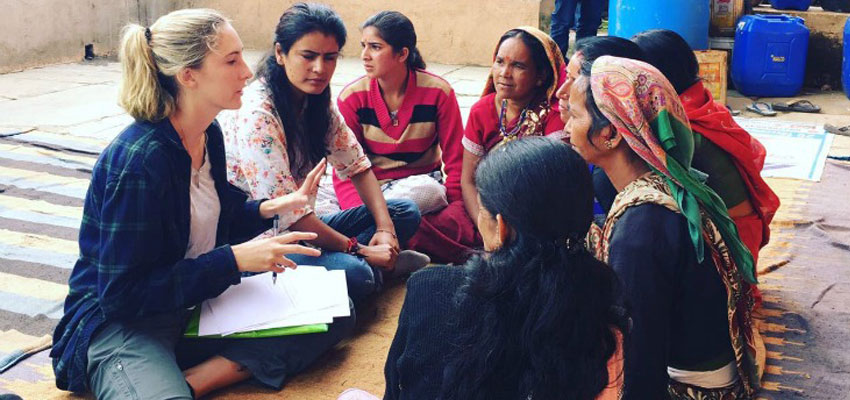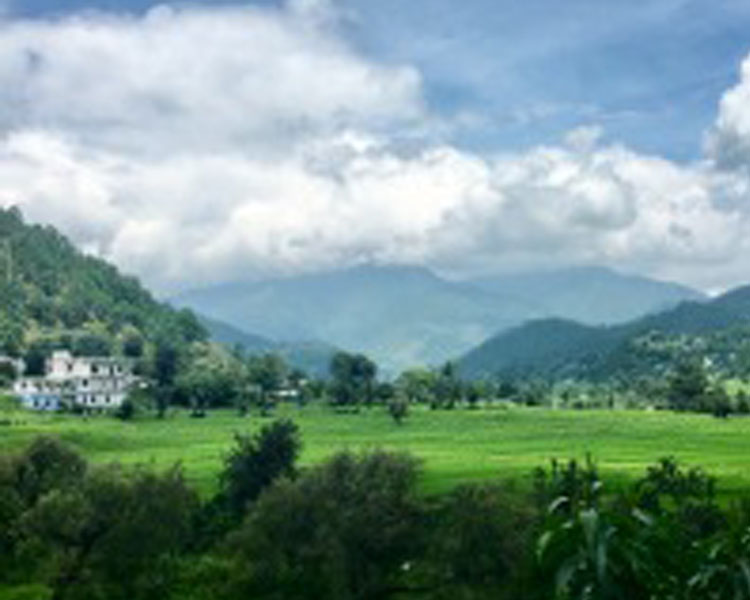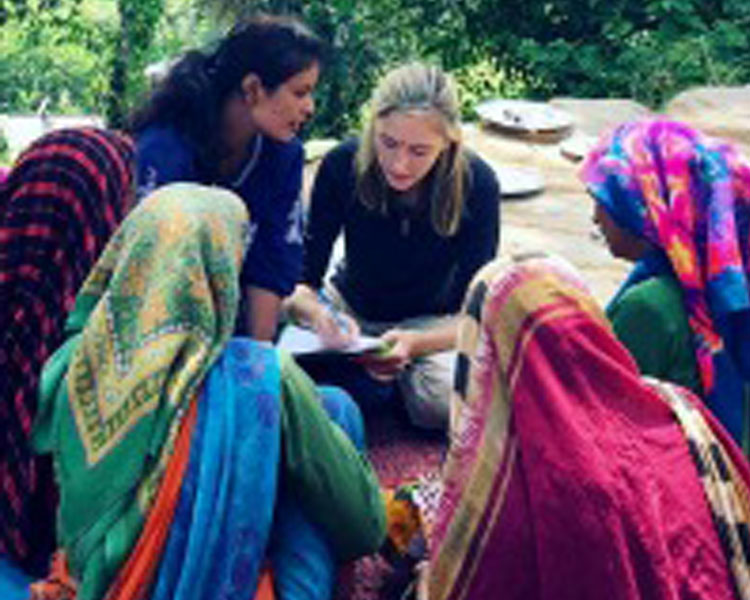
“I am inspired by the potential of the xylem water filter to benefit many families with few, if any, affordable filtration options. This research experience has also helped me define my own career goals working in international development, economics, and public health ... I hope to take my experiences back to the classroom and initiate discussion about our role, as global citizens and Americans, in international development."
Over the past year, I have had the opportunity to conduct field research in India for MIT D-Lab on a project titled “Development of Low-Cost Water Filter Using Sapwood Xylem.” The goal of this project is to introduce a low-cost water filter that will be less expensive than any other filter currently on the market and affordable to the poorest households. Xylem from coniferous trees has been proven to filter out all bacteria and protozoa and can be produced using the natural resource of pine trees.
The principal investigators of the J-WAFS-supported project, are Rohit Karnik, Associate Professor of Mechanical Engineering and Amy Smith, Senior Lecturer, Department of Mechanical Engineering and Founding Director of, MIT D-Lab.
I worked with D-Lab research associate Megha Hegde to conduct a needs assessment in Uttarakhand, India to determine current needs related to drinking water treatment and usage of water filters. We chose the Uttarakhand region for our assessment because of the potential for the xylem filter to be successful. Uttarakhand is abundant in pine tree forests, making local manufacturing feasible. Villagers in this region could benefit from the commercialization of a low-cost filter.
First Trip Overview - January 2017
Our first trip to Uttarakhand was in January 2017. We partnered with local NGO People’s Science Institute (PSI) and spent the month traveling to villages surrounding Almora and Bageshwar. PSI interns Vikram Negi, Deepak Bhatt and Chandra Kohli provided assistance on the trip.
We conducted 270 household interviews, five focus groups, two design workshops, and interviewed stakeholders including doctors, water filter vendors and NGO staff. We found that filters were being used in towns and cities, but there was very little filter usage or any type of water treatment in the villages. Those who did have filters were not using them regularly and were not properly maintaining them and changing the filter material.
The lack of water treatment is due to both affordability and awareness. The filters that are currently on the market are too expensive for most people living in the villages, and the cost of replacing the filter material is also too high. However, the larger issue seems to be that people do not think they need to treat their water. Most people in Uttarakhand get their drinking water from natural springs, and they believe that the spring water is pure and free of contaminants. However, this is not the case, as the water testing data from PSI indicated bacterial contamination in spring water. Doctors we interviewed told us that the incidence of water born disease is increasing and that children are most affected. Cases of disease increase during the monsoon season.
Second Trip Overview - August 2017
Our second trip was in August 2017 and lasted for 17 days. We traveled to the same region in Uttarakhand and conducted our assessment in villages surrounding the town of Ranikhet. For this study, we partnered with the non-profit Pan Himalayan Grassroots based in Ranikhet. They helped us select the villages and conduct our research activities. We conducted about 100 household interviews, 12 hand-on workshops, filter supply chain mapping and water quality tests. During this trip, we focused more on the feasibility of introducing the xylem water filter to villages in this region. We asked more questions about filter maintenance and price preferences. We found that many people would rather pay more and have to change the filter material less frequently. This was due primarily to the fact that the filter replacement material is only sold in the larger markets and villagers must travel a long way to purchase it, which is costly and time-consuming. This information will be critical to the next steps in implementing the xylem filter, as the material for this filter must be changed weekly.
We also took water samples from springs and containers of drinking water from each village that we visited and tested the samples for coliform and E. coli bacteria. We used these tests to convince villagers that there is a need for filters in their villages. We found coliform growth in every sample and E. coli growth in eight of the 19 samples. We are still in the process of analyzing the data to determine if the water is safe to drink.
Reflections
I am inspired by the potential of the xylem water filter to benefit many families with few, if any, affordable filtration options. This research experience has also helped me define my own career goals working in international development, economics, and public health. I can’t thank MIT D-Lab and Megha Hegde enough for this incredible opportunity. I hope to take my experiences back to the classroom and initiate discussion about our role, as global citizens and Americans, in international development.
I thoroughly enjoyed working with the local university students, Vikram and Chandra. We became great friends and learned how much we have in common. Chandra worked with me for the duration of the project both times and we continue to stay in touch.
I was trained at MIT on how to work with a translator and make sure that what I am asking is conveyed well and the information I receive is accurate. Chandra and I worked well together and she taught me how to introduce myself and thank our interviewees in Hindi, and also helped me have non-work related conversations with many people I met.
Our first trip to Uttarakhand was my first time leaving the United States, and it was quite an experience. I was blown away by the beauty of the hills and the bright colors of the houses and clothing. Everything there was so different and exciting. There are no traffic laws or really much of a structure to how the people, cars, and animals move in India. Yet, it somehow works. One of my favorite things that we did in Dehradun was ride on the rickshaws. It was like riding a rollercoaster, except with so much more to see and a bit more of an adrenaline rush.
I learned so much and met many different families through the interviews and workshops. Each day went similarly: Chandra and I would go from household to household to do interviews of the women living there. We would complete about 15 interviews a day. However, each village was different and each had its own water related issues. Granted, many of these issues overlapped between villages, but the priorities of the villagers and what problems they found to be the most difficult varied.
The second time traveling to Uttarakhand, I was surprised at how familiar the tastes, smells and language all were. I remembered the Hindi phrases I had learned in January and the interview process was more comfortable than before. I felt more confident in myself and my abilities, and was able to build on my interviewing skills.
Although certain aspects were familiar, I was constantly learning about the people and their culture and environment. I learned more about villagers’ lives and how their society functions. I learned that women spend their days working in the fields, taking care of children and feeding, washing and herding livestock. Meanwhile, men usually have jobs in the markets or have migrated to cities for work. I also learned that the climate can have enormous impacts on the economy and public health of villages. In one village we visited in August, women told us that some of their crops were dying due to the abnormal lack of rain during the monsoon season. (It only rained twice during the two weeks that we were in Ranikhet.)
The biggest challenge to the development of the xylem filter will be access and affordability to the people in developing countries who will benefit the most from it. A huge factor that contributes to the ability of villagers to buy and replace filter material in a timely manner is where the filter material is sold.
Currently, filter replacement material is only sold in the larger markets, which are far from most villages. The villagers do not have enough time or money to travel to the large markets regularly. If the filter replacement material for the xylem filter could be sold in smaller markets within the villages, then the village store-owners could profit and it would be possible for many villagers to maintain their water filters and have clean drinking water. It may even be incentive for more villagers to purchase water filters, specifically the xylem water filter.
However, this system still will not be successful without the educational component. People in the villages are not aware of how their drinking water may be causing health issues. In the villages that we visited, while water related illnesses such as diarrhea, dysentery and pilia (jaundice), are present, they are not at an epidemic level. The water may cause children and elderly people to fall ill a few times a year, but their lives are not at any great risk. In addition, the villagers firmly believe that the spring water is pure. This may have been true years ago, but an increase in population and livestock has resulted in bacterial contamination of the springs and rivers. How can we convince them that water filtration is important to their health? It is important to share water-testing data with the villagers in a way that they can understand, and to hold workshops to inform them about the health risks associated with drinking untreated water. It is equally important that they understand how the filter works and that it will not properly filter the water if not maintained and used right.
Although the xylem filter is still in the early stages of development and is not yet ready to be produced on a mass scale, I am hopeful that this product will have an impact on the lives of people living in undeveloped communities, whether in Uttarakhand or elsewhere in the world.





